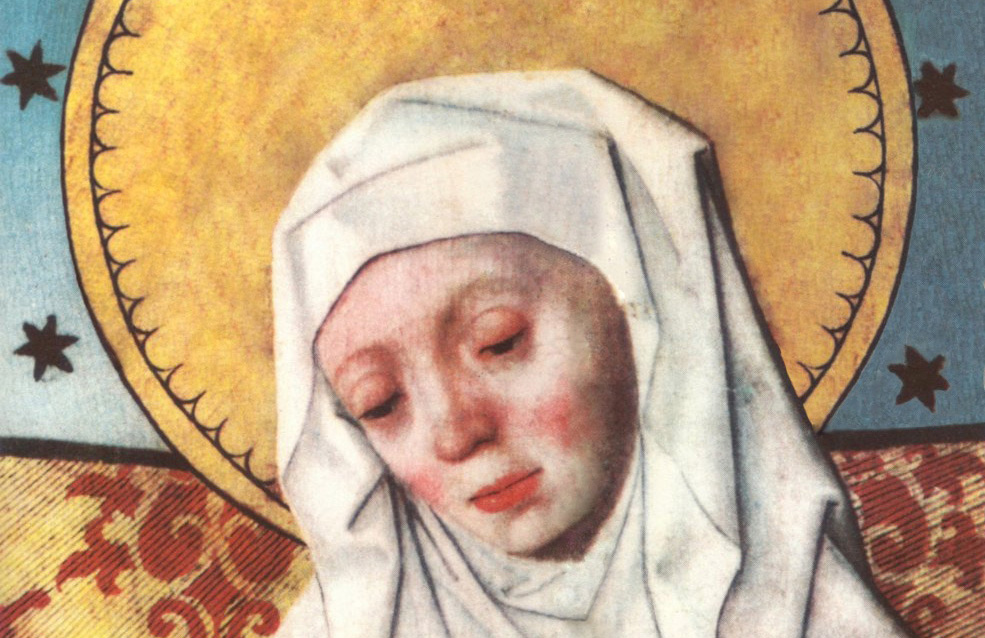‘The world would have peace if only men of politics would follow the Gospels.’
St. Bridget’s (1303-1373) life can be divided into two stages. First, there was the life of a wife and mother drawn into service of the Swedish royal house. Then, after her husband’s death, St. Bridget became a prophetic voice to kings and popes as a bride of Christ.
The underlying and unifying thread of Bridget’s entire life was a mystical relationship with the Lord, which intensified with each passing year. From a young age she began receiving private visions and revelations. Over the years she heard the voices of Christ and various saints, received admonitions to deliver to those who needed to hear them, and was instructed to crisscross Europe as an ambassador of truth and peace.
Bridget came from a family of means. In his day, the saint’s father was one of the wealthiest property owners in Sweden. On her mother’s side, Bridget was related to the Swedish kings of her era. At 13, Bridget was married to Ulf Gudmarsson. Their union produced eight children, all who survived infancy.
A devoted wife and mother, Bridget had a charitable heart that spilled over into society. She showed great generosity and love to indigent, single mothers and their children in her community. By her mid-30s, Bridget was requested for assistance at the royal court, as the primary lady-in-waiting for Sweden’s new queen.
After a 1344 pilgrimage together to Santiago de Compostela in Spain, Bridget’s husband died. From then onward, Bridget adopted a penitential life and entered a mystical union with Christ committed to his service.
As Bridget’s private revelations began to increase, the Lord began making more requests of her. And she began experiencing the true freedom found only in Christ, which enabled her to speak and act boldly, particularly so for a woman of her time. Fueled by her communications from on high, Bridget was endowed with fortitude and eloquence to prick the conscience of those she encountered. She was known to speak admonitions to people she met on the street just as clearly and profoundly as she would to kings and popes.
Bridget worked to bring changes to the Swedish court of her cousin and attempted to persuade French and English kings to avoid what turned into The Hundred Years’ War. She admonished popes for living away from Rome and allowing a corrupt culture to flourish in the Church. There was an urgency in Bridget’s call for ecclesial reforms, as she cried out to the Lord, “The Catholic faith may soon go under.”
One cannot measure Bridget’s success in these endeavors by earthly standards, but can observe a wholehearted obedience to the Lord and a willingness to speak the truth without counting the cost. She offered a witness of holiness, boldness and devotion amid a world needing it as much then as it does now.
Another instruction the Lord gave to Bridget was to establish a new religious community. She sought approval of her rule in Rome, which took some time. While there, she established temporary residence and set up a center for pilgrims from the north country. Bridget desired to return to her native Sweden to establish her monastery, but died before that was possible. A daughter, Catherine — herself a saint — became the first abbess of the religious community that Bridget began at the Lord’s request, called the Order of the Most Holy Savior, or Brigittines. The community came to fruition only after Bridget’s death.
St. Bridget died in Rome in 1373 and was canonized just 18 years later. In 1999, she was named one of Europe’s principal patrons by Pope St. John Paul II. Her feast is July 23.
Michael R. Heinlein is editor of OSV’s Simply Catholic and a graduate of The Catholic University
of America. He writes from Indiana. This article is taken from the ‘Saints in Time of Crisis’ booklet from Our Sunday Visitor.

